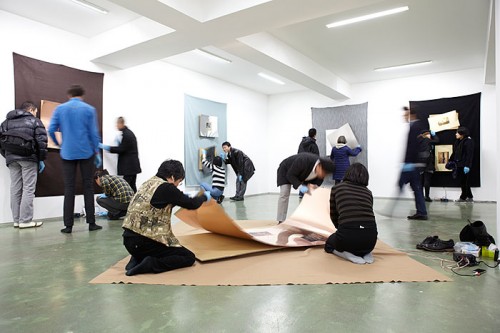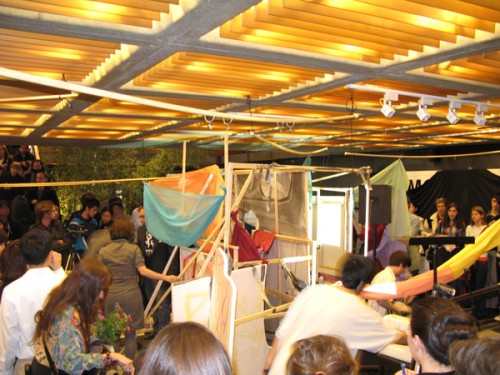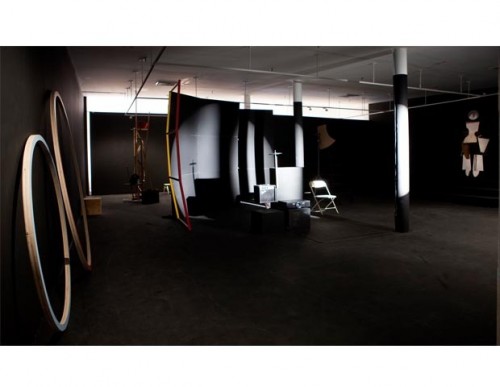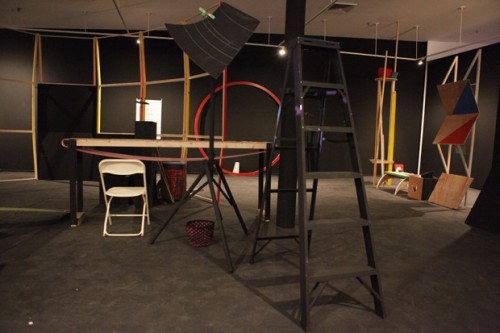In my last post, I took an historical look at collaborative approaches to the intersection of objects and performance, but there are many artists working today that continue this line of inquiry. Working with groups of collaborators, some of whom shift between the roles of co-author and scripted performer, I would like to consider two artists working today who seem to take their cues more from Allan Kaprow or a Fluxus working-style (although some may directly reference groups like Gutai), so that the objects, while important for the performances themselves, really become secondary–they serve as the support structure for the organization of the performance. This probably reflects, in part, an opening up of the definition of art object that allows performance to legitimately hold that position, but I would posit that it also reflects anxieties around material production and the value assigned to the material over the social.
Upon seeing his 2007 Performa contribution Bring Your Own Flowers, I was struck by Ei Arakawa‘s use of performance in combination with physical structures to effect an atmosphere of instability and impermanence, shifting focus from the usual points of interest in a work (central actions, completed compositions) to the overall flow of energy and materials–the process became the performance itself. In the case of BYOF, staged in the lobby of the Japan Society, the main construction served to divide the action so that no one vantage point allowed a full view of the work. The audience had to physically follow along to see what was happening, but the focus on each main action–an auction of spontaneous cereal box “artworks,” a lecture on alcoholic artists and critics, the “painting” of styrofoam and wood panel surfaces with flowers contributed by the audience, a restaging of an interview between Amy Sillman and Phong Bui–was undermined by a minor event: a bar selling PBR, the parading in of two of Sillman’s paintings, and the construction and deconstruction of partitions that occurred just beyond view or literally overlapped with the main action, dispersing attention and making it impossible to follow everything that was happening.
Similarly, value definitions were consistently undermined: many of the performers were recognizable artists themselves, and the boundaries between script and spontaneous action and dialogue were indecipherable, problematizing definitions of authorship. Nothing of conventional material value was created through this process of the installation, even through the potential to do so existed within many of the actions. The auctioned cereal box compositions came closest, but since they were made of carelessly torn cardboard, they still served more as supports for action than actual objects of value. In fact, by the end of the performance the entire set had been deconstructed, leaving one with only the memory of certain compositional moments,where the disparate objects and actions coalesced into a seemingly complete aesthetic construction, only to be rearranged in the next instant.

Ei Arakawa and Sergei Tcherepnin. View of "Looking at Listening," Taka Ishii Gallery, Tokyo, 2011–2012.
This chaotic, decentralized structure seems to hold true through many of Arakawa’s works. Kevin McGarry, writing of a collaboration between Ei Arakawa and Sergei Tcherepnin at Taka Ishii Gallery earlier this year, noted:
“The show ended in chaos, typically. On Saturday, January 14th, two incongruous flutists drifted into the exhibition space filled with visitors bending and shaking the cacophonous sculptures…The works consisted of metal panels imprinted with images and mounted on felt-draped devices—cool, clean, basic elements assembled like a science fair project, belying neither their mid-century performance art roots nor their unabashed functionality. The images were sourced from the New York Public Library, where the artists found them catalogued in a file called “Listening” or in other categories which one could consider visual variations on the theme: “Conversation,” “Investigation,” “Town Meetings,” “Audience 1960s–70s.” . . . Gallery visitors were encouraged to slip on blue latex gloves in order to manhandle the singing sculptures. The artists demonstrated the manhandling themselves, lovingly maneuvering their sculptures as absurd instruments, prying the plates off their mounts by their edges, muffling them with the fabric, or whirling them like a pinwheel.”
Combining live performance with audience members’ improvisations, once again undermining authorial definitions and blurring conventional relationships between artist, art object, and audience, Arakawa and Tcherepnin seem to strive for a new conception of listening as physical group action. As McGarry relates, “During the performance all the sculptures emitted sound at once: standing in the room felt like being in a planetarium show or encircled by echo-locating dolphins—an acutely aural yet distinctly spatial experience.” Listening, typically thought of as a personal, quiet activity, is inverted into a clamorous group activity through the support of these odd objects that soften boundaries between viewing, making, performing and listening.
Looking through Arakawa’s larger body of work, these themes of communal activity, dispersed focus, continuous construction and destruction, as well as ambiguous definitions consistently emerge, but in different formations that force the viewer to sound out these qualities again and again. For example, Arakawa’s “Lives of Peformers,” a collaboration with Silke Otto-Knapp that incorporates her paintings of performers, pushes performing bodies from stage to canvas to park through the use of video, shifting bodies from active performer to inanimate object, from live action to virtual representation. What remains consistent is a focus on the social, a denial of the immutability of the material object, and a use of the material as a support for exploring interaction. The social becomes the focus of the work, uncovering the ability of the material object to serve as a conduit through which the social can be amplified and, for a short time, manifest physically.
Working in similarly communal, interactive arrangements, Ohad Meromi draws inspiration from his roots (having been born on an Israeli kibbutz) and from modernist forms of theater. Basing his thinking around questioning the definition of a stage, Meromi tries to minimize the markers of the stage while expanding its space to become an all-encompassing structure into which the audience is subsumed. As Meromi himself has written:
“I’m very interested in thinking about the performative as a site for learning rather then a show or a spectacle. Eliminating the audience allows one to think of relationship between the actor and the script—the actor and the idea. There’s also Augusto Boal’s term spect-actor, which has to do with the attempt to provide agency to the participant.”
In this line of thinking, Meromi has created works like Rehearsal Sculpture at Art in General, setting up spaces for interaction, creating series of props and scripts, but allowing audience and occasional performers plenty of space to interpret these materials as they wish. Specifically in the case of Rehersal Sculpture, Meromi painted over the entire space to turn it into a black box, but by including a set of risers that could also serve as platforms and providing no clear boundaries for the rest of the space, he transformed the entire space into a potential stage. During a series of Rehearsal events, Meromi invited collaborators to come in and lead workshops, some of which were more overtly performative in nature than others. The one I attended drew its inspiration from a constructivist-style collage but shifted that composition into a group performance.
All attendees were recruited to participate and divided into groups. Each group was assigned a geometrically-inspired movement and instructed to walk a path designated by tape on the floor, related to the “shape” of our movement. As these paths intersected and navigated the architectural props of the installation, and as we were assigned ever more complex rythmical patterns to follow (lead by drumbeat) the overall performance became more and more complex, belying the apparent simplicity of the performance structure. As the entire audience was incorporated into the action, no one could claim an objective view of the performance; viewable only within the structure of the performance, the physical interaction with the space, negotiations with our co-performers, and bodily exertions in an attempt to follow the given instructions became the aesthetic experience of the performance. It could not exist without us, nor could we accomplish the performance on its own, so this mutual dependence came to define the social exchange of this “rehearsal.”
Each of these “rehearsal” exchanges is a bit improvisational, directed initially by a script, or the potential of the architectures, hoops, sticks, flags, and other constructivist-inspired props Meromi stocks the space with, but shifted in response to the impulses of the leaders and participants. While Meromi will usually work with the workshop leaders to discuss the initial concept of the workshop in advance, he leaves these collaborations open-ended and filled with mundane non-performative actions (his example of this being the act of smoking) so that these spaces can become a small-scale, problem-solving spaces. He does not seem intent upon fixing practical problems, but rather in re-imagining the communist experiment and working, in an abstract, model form, to understand where it went wrong so that we can start to reimagine the potentials of the social realm to push toward a more fulfilling future. Props are relegated to a secondary, symbolic position, referencing the history of material production within modernist and communist ideologies. However, considering that these are produced after the failure of these ideologies and are removed from a reverential status to be repositioned as supports for development of new models, they seem to point toward a desire to at least reconsider the potential of these material products (now actually material remains) for the construction (physical and metaphorical) of an alternative system.
For both Meromi and Arakawa, the material has become a support structure for the refiguring of social interactions. While still keeping material production as a part of their artistic practices, they shift the focus onto the social in an attempt to restructure the values of the artworld and, potentially, a larger swath of society. Unlike the artists mentioned in my previous post, who simply wanted to shift the place of art into the everyday, these artist seem to seek a shift of consciousness, positioning the material as supplemental to the social. At the same time, a continued insistence on the material as a means of effecting social interaction links back to an attempt to circumvent the apparent virtual trajectory of social interaction with the rise of telecommunications. Linking the social to the material, they insist upon the necessity of physical interaction to effect a more complete social exchange, and provide a space for rethinking our societal values.






